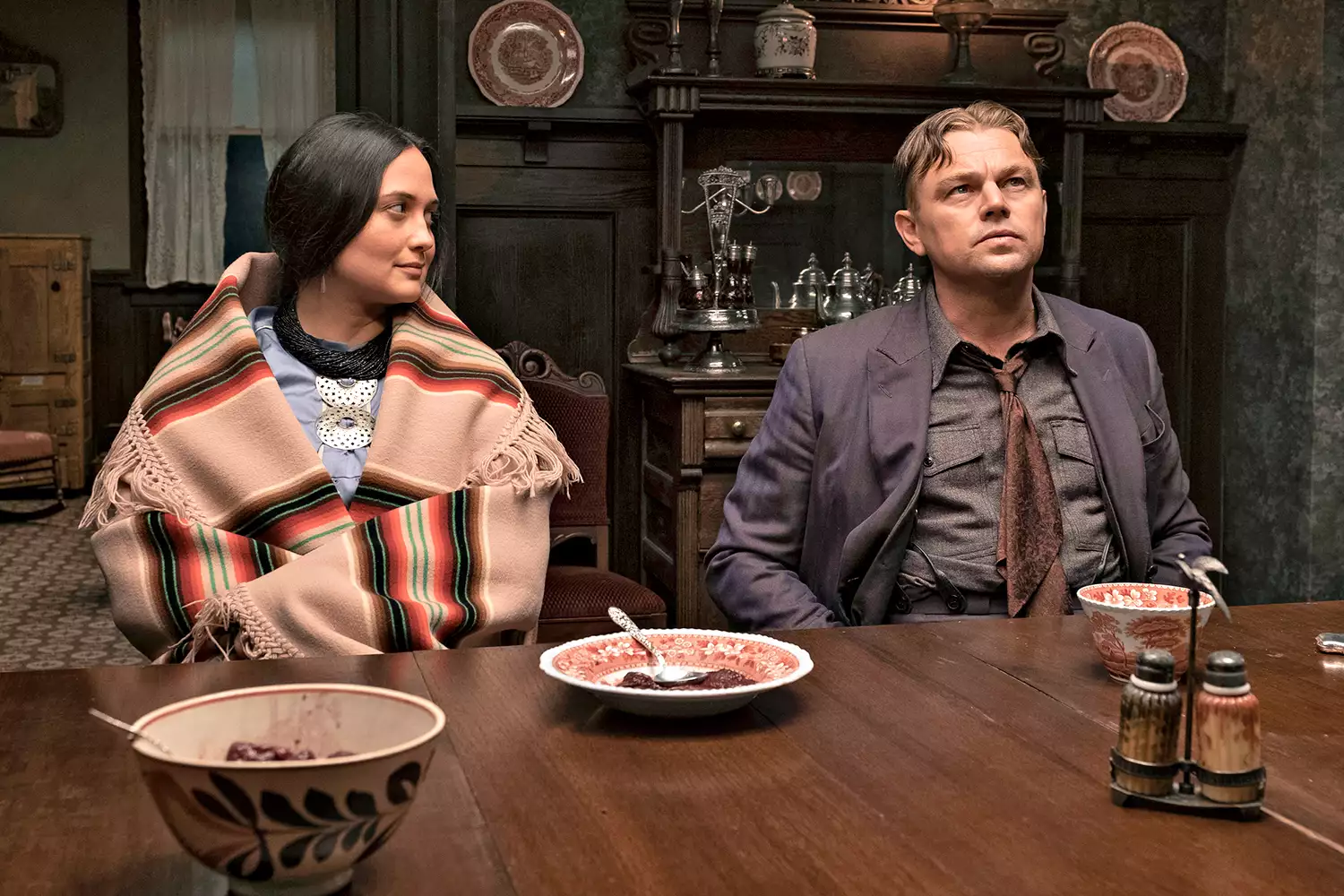Directed by the iconic Martin Scorsese, “Killers of the Flower Moon” delves deep into the haunting and authentic narrative of the Reign of Terror, a chilling series of murders that shook the Osage Nation in the 1920s. In this compelling film, Oscar-winning actor Leonardo DiCaprio embodies the character of Ernest Burkhart, a white man who enters Oklahoma, marries a wealthy Osage woman named Mollie, portrayed by Lily Gladstone, and becomes ensnared in a nefarious plot to eliminate her family and lay claim to their valuable oil rights. Orchestrating this malevolent scheme is William K. Hale, a prosperous cattle rancher and Burkhart’s uncle, brought to life by the legendary Oscar winner Robert De Niro, a long-time Scorsese collaborator.
Derived from David Grann’s non-fiction book of the same name, “Killers of the Flower Moon” thrusts the Osage story into the spotlight, unveiling the authentic events that inspired this cinematic masterpiece. Here, we take an in-depth look at the gripping history:
The Osage Nation: A Rich Heritage The Osage Nation is a Native American tribe rooted in the Midwest. In the 19th century, the U.S. government compelled the tribe to relocate to Oklahoma, resulting in the loss of 95% of their population, according to the Osage Nation Foundation. However, their fortune took an unexpected turn in 1894 when oil was discovered on Osage land. By 1906, the tribe had secured mineral rights to the oil, leading to an influx of millions of dollars and establishing the Osage Nation as one of the wealthiest communities.
Nonetheless, this newfound prosperity also attracted malevolent forces. Many tribal members became targets of opportunists and murderers intent on seizing their fortunes. The U.S. government exacerbated their plight, making it arduous for Osage individuals to access their wealth. Grann’s book discloses that many full-blooded Osages were declared “incompetent,” necessitating a White guardian to oversee their finances. This meant that even routine expenses, such as buying groceries, required approval from their guardians.
The Burkharts: A Fateful Union Mollie Kyle, a member of a well-off Osage family with oil headrights, wed Ernest Burkhart in 1917. Ernest, a White man hailing from Texas, came to reside with his uncle, William Hale. Their union unfolded in a rather unconventional manner – Ernest worked as a cab driver and it was during a cab ride that he and Mollie’s path crossed. Their love blossomed, resulting in three children: Elizabeth, James “Cowboy,” and Anna, who tragically fell victim to whooping cough during her childhood.
The Enigma of William Hale William King Hale, a White cattle baron in Osage County, Oklahoma, wielded considerable power in the region and ranked among the wealthiest individuals, as per Grann’s book. Hale regarded himself as a friend of the Osage tribe and earned the moniker “King of Osage Hills.” Despite maintaining close friendships with Osage Nation members, Hale masterminded a sinister plot to murder Osages and seize their oil rights. He recruited his nephews, Ernest and Byron, along with others, to execute this malevolent agenda.
The Reign of Terror: A Nightmarish Epoch The Reign of Terror commenced in the 1920s when numerous Osage people began dying under perplexing circumstances. Opportunists aiming to lay claim to the Osage oil fortune were behind these brutal murders. Osage oil rights could only be inherited, not purchased, leading to a series of nightmarish crimes.
At the core of the film lies the Burkhart family. Mollie’s sister, Minnie, succumbed to a mysterious “wasting illness” in 1918, a fate that befell other Osage individuals during that period. Mollie’s suspicions were further aroused when her sister Anna was found shot to death in a remote Osage County ravine in 1921. Their mother, Lizzie Q., passed away under suspicious circumstances mere months later. In 1923, another sister, Rita, perished when her house was bombed. These horrors culminated in Mollie and Ernest inheriting the lucrative oil rights, as Hale had intended.
While the exact number of Osages killed during the Reign of Terror remains uncertain, it could potentially have reached into the hundreds. Countless millions of dollars were stolen from the Osage people, and many lives were lost.
The End of the Reign of Terror: Justice Prevails In the initial years of the Reign of Terror, corrupt local authorities declined to conduct proper investigations into the crimes. Consequently, Hale assisted Mollie in hiring a private investigator to delve into Anna’s death. However, following Rita’s demise and impassioned pleas from the Osage Nation for federal intervention, J. Edgar Hoover was appointed as the director of the Bureau of Investigation, which would later become the FBI. In 1925, special agent Tom White was dispatched to Osage County. Authorities harbored suspicions against Hale and Ernest, and the investigation took a pivotal turn when Ernest confessed to his crimes. He later testified against his uncle in court, resulting in both their convictions for murder.
The Enigmatic Poisoning of Mollie: A Mystery Unveiled The film suggests that Mollie, a diabetic, may have been poisoned, leading to her declining health over the years. In the movie, the Shoun Brothers, doctors associated with Hale, administer shots to Mollie, supposedly insulin. However, these injections render her bedridden and on the brink of death. Ernest, who administered the shots, insisted that she continue taking them. Mollie’s recovery only began after receiving care from other doctors.
In reality, authorities believed that Mollie was provided something to keep her silent amid the murders, although it remains unclear whether Ernest was aware of this sinister plot. The film intentionally maintains ambiguity regarding Ernest’s knowledge.
A Tragic Love Story: Mollie’s Second Chance Despite the tumultuous circumstances, Margie Burkhart, the granddaughter of Mollie and Ernest, believes that her grandfather genuinely loved her grandmother. Following Ernest’s guilty plea, Mollie divorced him and never uttered his name again. She later remarried and regained control of her finances, ultimately being declared “competent.” Mollie passed away in 1937.
“Killers of the Flower Moon” unfolds the harrowing saga of wealth, tragedy, and murder that gripped the Osage Nation, bringing this dark chapter in American history to life with unflinching authenticity.




